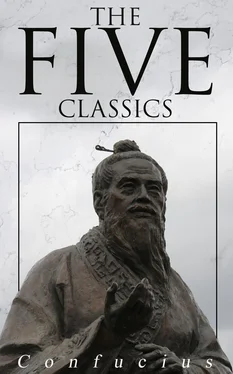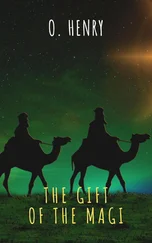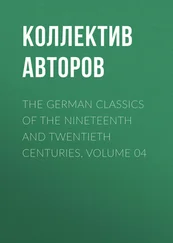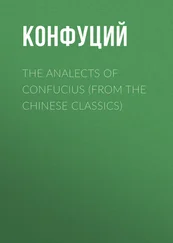1.See Plate I at the end of the Introduction.
2. K âu-ȝze, called K âu Tun-î and K âu Mâu-shuh, and, still more commonly, from the rivulet near which was his favourite residence, K âu Lien- kh î. Mayers (Chinese Reader's Manual, p. 23) says:--'He held various offices of state, and was for many years at the head of a galaxy of scholars who sought for instruction in matters of philosophy and research:--second only to K û Hsî in literary repute.'
3. K û-ȝze Kh wan shû, or Digest of Works of K û-ȝze, chap. 26 (the first chapter on the Yî), art. 16.
4.Analects IX, viii.
5.Lî K î VIII, iv, 16.
6.Shû V, xxii, 19.
7.See Mayers' Chinese Reader's Manual, pp. 56, 57.
8.Certainly it was not Confucius. See on the authorship of the Appendixes, and especially of Appendix III, in the next chapter.
9.For this dissection, which may also be called reductio ad absurdum, of the Lo writing, I was indebted first to P. Regis. See his Y-King I, p. 60. But K û Hsî also has got it in the Appendix to his 'Lessons on the Yî for the Young.'
10.The Shû IV, xi, 1, 2.
11.These were well-known instances of Shâu's wanton cruelty. Observing some people one winter's day wading through a stream, he ordered their legs to be cut through at the shank-bone, that he might see the marrow which could so endure the cold. 'The good man' was a relative of his own, called Pî-kan. Having enraged Shâu by the sternness of his rebukes, the tyrant ordered his heart to be cut out, that he might see the structure of a sage's heart.
12.We do not know what these contrivances were. But to please his wife, the infamous Tâ- k î, Shâu had made 'the Heater' and, 'the Roaster,' two instruments of torture. The latter was a copper pillar laid above a pit of burning charcoal, and made slippery; culprits were forced to walk along it.
13.The Shû V, i, Sect. iii, 2, 3.
14.Shû II, ii, 18.
15.Shû V, iv, 20-31.
16.In the Book of Poetry we have Wăn's grandfather (Than-fû, III, i, ode 3, 3) divining, and his son (king Wû, III, i, ode 10. 7) doing the same.
CHAPTER III
THE APPENDIXES
Table of Contents
1. Two things have to be considered in this chapter:--the authorship of the Appendixes, and their contents. The Text is ascribed, without dissentient voice, to king Wăn, the founder of the K âu dynasty, and his son Tan, better known as the duke of K âu; and I have, in the preceding chapters, given reasons for accepting that view. As regards the portion ascribed to king Wăn, the evidence of the third of the Appendixes and the statement of Sze-mâ Kh ien are as positive as could be desired; and as regards that ascribed to his son, there is no ground for calling in question the received tradition. The Appendixes have all been ascribed to Confucius, though not with entirely the same unanimity. Perhaps I have rather intimated my own opinion that this view cannot be sustained. I have pointed out that, even if it be true, between six and seven centuries elapsed after the Text of the classic appeared before the Appendixes were written; and I have said that, considering this fact, I cannot regard its two parts as a homogeneous whole, or as constituting one book in the ordinary acceptation of that name. Before entering on the question of the authorship, a very brief statement of the nature and number of the Appendixes will be advantageous.
2. They are reckoned to be ten, and called the Shih Yî or 'Ten Wings.' They are in reality not so many; but the Text is divided into two sections, called the Upper and Lower, or, as we should say, the first and second, and then the commentary on each section is made to form a separate Appendix. I have found it more convenient in the translation which follows to adopt a somewhat different arrangement.
My first Appendix, in two sections, embraces the first and second 'wings,' consisting of remarks on the paragraphs by king Wăn in the two parts of the Text.
My second Appendix, in two sections, embraces the third and fourth 'wings,' consisting of remarks on the symbolism of the duke of K âu in his explanation of the individual lines of the hexagrams.
My third Appendix, in two sections, embraces the fifth and sixth 'wings,' which bear the name in Chinese of 'Appended Sentences,' and constitute what is called by many 'the Great Treatise.' Each wing has been divided into twelve chapters of very different length, and I have followed this arrangement in my sections. This is the most important Appendix. It has less of the nature of commentary than the previous four wings. While explaining much of what is found in the Text, it diverges to the origin of the trigrams, the methods pursued in the practice of divination, the rise of many arts in the progress of civilisation, and other subjects.
My fourth Appendix, also in two sections, forms the seventh 'wing.' It is confined to an amplification of the expositions of the first and second hexagrams by king Wăn and his son, purporting to show how they may be interpreted of man's nature and doings.
My fifth Appendix is the eighth 'wing,' called 'Discourses on the Trigrams.' It treats of the different arrangement of these in respect of the seasons of the year and the cardinal points by Fû-hsî and king Wăn. It contains also one paragraph, which might seem to justify the view that there is a mythology in the Yî.
My sixth Appendix, in two sections, is the ninth 'wing,'--'a Treatise on the Sequence of the Hexagrams,' intended to trace the connexion of meaning between them in the order in which they follow one another in the Text of king Wăn.
My seventh Appendix is the tenth 'wing,' an exhibition of the meaning of the 64 hexagrams, not taken in succession, but promiscuously and at random, as they approximate to or are opposed to one another in meaning.
3. Such are the Appendixes of the Yî King. We have to enquire next who wrote them, and especially whether it be possible to accept the dictum that they were all written by Confucius. If they have come down to us, bearing unmistakeably the stamp of the mind and pencil of the great sage, we cannot but receive them with deference, not to say with reverence. If, on the contrary, it shall appear that with great part of them he had nothing to do, and that it is not certain that any part of them is from him, we shall feel entirely at liberty to exercise our own judgment on their contents, and weigh them in the balances of our reason.
None of the Appendixes, it is to be observed, bear the superscription of Confucius. There is not a single sentence in any one of them ascribing it to him. I gave in the first chapter, on p. 2, the earliest testimony that these treatises were produced by him. It is that of Sze-mâ Kh ien, whose 'Historical Records' must have appeared about the year 100 before our era. He ascribes all the Appendixes, except the last two of them, which he does not mention at all, expressly to Confucius; and this, no doubt, was the common belief in the fourth century after the sage's death.
But when we look for ourselves into the third and fourth Appendixes--the fifth, sixth, and seventh 'wings'--both of which are specified by Kh ien, we find it impossible to receive his statement about them. What is remarkable in both parts of the third is, the frequent occurrence of the formula, 'The Master said,' familiar to all readers of the Confucian Analects. Of course, the sentence following that formula, or the paragraph covered by it, was, in the judgment of the writer, in the language of Confucius; but what shall we say of the portions preceding and following? If he were the author of them, he would not thus be distinguishing himself from himself. The formula occurs in the third Appendix at least twenty-three times. Where we first meet with it, K û Hsî has a note to the effect that 'the Appendixes having been all made by Confucius, he ought not to be himself introducing the formula, "The Master said;" and that it may be presumed, wherever it occurs, that it is a subsequent addition to the Master's text.' One instance will show the futility of this attempt to solve the difficulty. The tenth chapter of Section i commences with the 59th paragraph:--
Читать дальше












